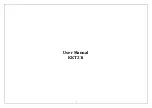
Colour Mobile Phone Dualband i2000 User’s Guide
INNOSTREAM Confidential
PAGE : 70 of 70
15. Index
! Note : The contents of user’ s guide is subject to change for technical improvement without
notice.
FCC & Industry Canada Regulatory Compliance
This device complies with Part 15 of the FCC Rules. Operation is subject to the following two conditions:
(1) this device may not cause harmful interference, and (2) this device must accept any interference
received, including interference that may cause undesired operation.
Your mobile device is a low power radio transmitter and receiver. When it is ON, it receives and also
sends out radio frequency (RF) signals. In August 1996, the Federal Communications Commission (FCC)
adopted RF exposure guidelines with safety levels for mobile device. Those guidelines are consistent
with safety standards previously set by both U.S. and international standards bodies: American National
Standard Institute (ANSI), National Council of Radiation Protection and Measurements (NCRP), and
International Commission on Non-Ionizing Radiation Protection (ICNRP). Those standards were based
on comprehensive and periodic evaluations of the relevant scientific literature. The design of your Module
complies with the FCC guidelines and applicable
Statement according to FCC part 15.105
NOTE
: This equipment has been tested and found to comply with the limits for a Class B digital device,
pursuant to Part 15 of the FCC Rules. These limits are designed to provide reasonable protection against
harmful interference in a residential installation. This equipment generates, uses and can radiate radio
frequency energy and, if not installed and used in accordance with the instructions, may cause harmful
interference to radio communications. However, there is no guarantee that interference will not occur in a
particular installation. If this equipment does cause harmful interference to radio or television reception,
which can be determined by turning the equipment off and on, the user is encouraged to try to correct the
interference by one or more of the following measures:
. Reorient or relocate the receiving antenna.
. Increase the separation between the equipment and receiver.
. Connect the equipment into an outlet on a circuit different from that to which the receiver is connected.
. Consult the dealer or an experienced radio/TV technician for help.
RF exposure FCC
For body worn operation, to maintain compliance with FCC RF exposure guidelines, use only accessories
that contain no metallic components and provide a separation distance of 15mm (0.6 inches) to the body.
Use of other accessories may violate FCC RF exposure guidelines and should be avoided.
Health and Safety Information FCC
This EUT has been shown to be capable of compliance for localized specific absorption rate (SAR) for
uncontrolled environment/general population exposure limits specified in ANSI/IEEE Std. C95.1-1992 and
had been tested in accordance with the measurement procedures specified in FCC/OET Bulletin 65
Supplement C (2001) and IEEE Std. 1528-200X (Draft 6.5, January 2002).
Ministry of Health (Canada), Safety Code 6. The standards include a substantial safety margin designed
to assure the safety of all persons, regardless of age and health. The exposure standard for wireless
mobile phones employs a unit of measurement known as the Specific Absorption Rate, or SAR. The SAR
limit set by the FCC is 1.6W/kg *.

















